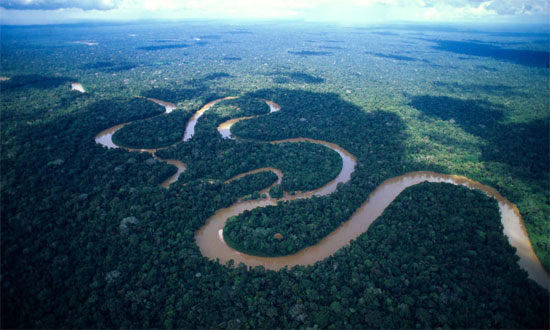The Amazon River emits most of the carbon absorbed by the Amazon
(Amazonoctv) - The Amazon River emits almost all of the carbon absorbed by the tropical rainforest.
The Amazon rainforest, which is considered to be the lungs of the earth, absorbs carbon dioxide and releases large amounts of oxygen. Forest plants use carbon dioxide in the atmosphere to photosynthesize, form parts of the plant, these parts eventually fall, fall to the ground and decompose or swept away by stormwater runoff.
Until recently, it was believed that a large amount of rainforest carbon was washed down into the Amazon River and buried deep in the oceans. But a recent study conducted by researchers at the University of Washington, USA showed that the river emits a large amount of carbon dioxide - although it has yet to answer the question of how that might happen. , while stems and bark are thought to be difficult to decompose by river bacteria.
A study published this week in Nature Geoscience solved the conundrum, demonstrating that matter from woody plants decomposes almost entirely by the bacteria of the Amazon River and parts. Hardness of this plant plays an important role in the 'breathing' of the river.

This finding has great implications for global carbon models as well as the ecology of the Amazon and other rivers in the world.
"People think it's part of the ocean-pouring compounds ," said Nick Ward, the study's first author. 'We see that carbon is respected and basically becomes carbon dioxide when it moves into the river'.
Lignin is the substance that helps form the main component of wood tissue, the second most common compound of terrestrial plants. Scientists once believed that many of these compounds were buried in the ocean floor for centuries or millennia. However, the new paper published in the study shows that the bacteria in the river broke lignin within 2 weeks, and only 5% of the Amazon rainforest ever flowed to the ocean.
"The river was once considered a passive pipe," said co-author of the study, University of Washington co-author Jeffrey Richey. 'This study shows that they have many metabolic hotspots'.
When previous studies showed that the amount of carbon dioxide was released from rivers, scientists knew that this amount of carbon dioxide did not increase. They speculate that there may be a short-term carbon source that freshwater bacteria can convert into carbon dioxide.
'The fact that lignin is showing this metabolic activity is a big surprise' . Richey said. 'It is a mechanism for the role of rivers in the global carbon cycle - it is' food 'for river respiration.'
The Amazon River alone accounts for about one fifth of the earth's total fresh water and plays an important role in global processes, but also serves as an experiment on natural river ecosystems.
Richey and his colleagues have studied the Amazon River for more than three decades. Previous research lies about 500 miles upstream. This time, US and Brazilian research groups have explored the relationship between rivers and oceans, which means studying at the world's largest estuaries - a dangerous research location. .

'There is a reason that nobody has really researched in this area,' Ward said. 'Successful implementation has been a challenge. It is a big part and trouble of water '.
The team used flat-bottom ships to go through the three estuaries, each of which was so wide that you could not see the shore, in the water rich in wave sediments comparable to milk chocolate. The tide is up to 30 feet, pushing back the freshwater flow at the river mouth, and the wind speed is up to 35mph.
Under these conditions, Ward took samples of river water in all four seasons. He compared the original samples to the remaining samples for 4 weeks at the temperature of the river. Back at the University of Washington, he used newly developed techniques to scan samples for about 100 compounds, including 95% plant-derived lignin. Previous techniques can only determine about 1% of carbon in plant origin in the country.
Based on these results, the author estimated that about 45% of Amazon lignin is broken in the soil, 55% breaks in the river system and 5% goes to the sea, where it can be broken. or sink into the sea.
Everyone has just acknowledged, 'We think that when the rain falls to the ground, it entails lignin compounds, it also entails populations of bacteria that can digest lignin' well.
The research is supported by Gordon and Betty Moore, the National Science Foundation and the Research Council for the State of São Paulo. Co-author is Richard Keil at UW; Patricia Medeiros and Patricia Yager at the University of Georgia; Daimio Brito and Alan Cunha at the Federal University of Amap in Brazil; Thorsten DITTMAR at Carl von Ossietzky University in Germany, and Alex Krusche at São Paulo University in Brazil.
- Found the cause of the Amazon River instead of flow
- Why does the Amazon River longer than 6,000km without a bridge spanning?
- The Amazon river system originated in Peru
- Amazon underground river is not ... river
- The river has two colors of water mixed in Brazil
- Drought threatens Amazon carbon sinks
- The new discovery helps the Amazon River become the world's longest river
- The river boiled water boiled everything in the Amazon forest
- Amazon River 11 million years old
- Amazon's freshwater ecosystem is sensitive to environmental degradation
- The Amazon River hydropower project continues
- Giant monster in the Amazon River before extinction
 Is the magnetic North Pole shift dangerous to humanity?
Is the magnetic North Pole shift dangerous to humanity? Washington legalizes the recycling of human bodies into fertilizer
Washington legalizes the recycling of human bodies into fertilizer Lightning stone - the mysterious guest
Lightning stone - the mysterious guest Stunned by the mysterious sunset, strange appearance
Stunned by the mysterious sunset, strange appearance